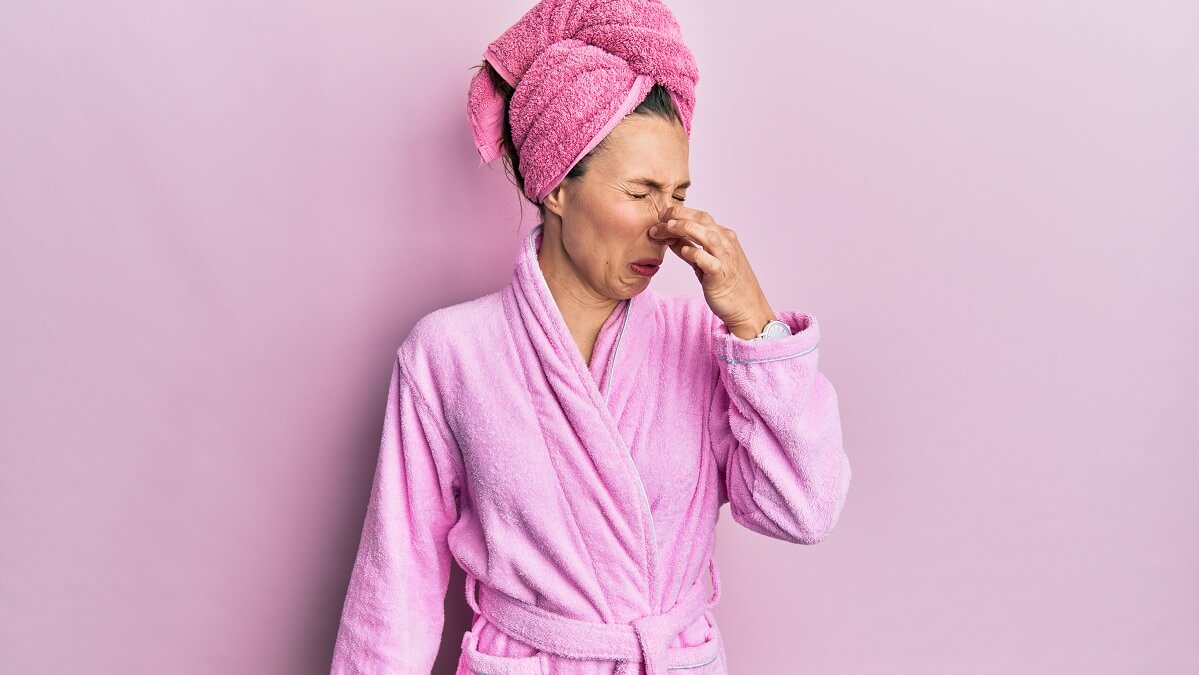Reducing toxins in the home can feel daunting, but it’s important to remember that little steps can make a huge difference over time. To avoid getting overwhelmed, decide on just one thing from this list to swap at a time.
Dental floss that contains PFAS
It is well known that non-stick cookware can contain PFAS, a group of chemicals that have been linked to hormone disruption, reproductive issues, and certain cancers. However, what you may not be aware of is that dental floss can also contain PFAS: a 2019 study in Nature found that using coated floss is associated with higher levels of PFAS markers in the blood.
Personal care products containing formaldehyde
Safe Cosmetics Australia explains that formaldehyde and formaldehyde-releasing ingredients are used in many personal care products, particularly in shampoos and liquid body soaps. These chemicals help prevent bacteria from growing in water-based products, but can be absorbed through the skin and have been linked to both skin sensitivity and cancer. One of them is a preservative named DMDM Hydantoin, which many cosmetics brands use in place of Parabens.
Read: How to sanitise your make-up
Product Safety Australia confirms that low levels of formaldehyde can be found in many consumer products including cosmetics and personal care products such as shampoos and conditioners, shower gels, liquid hand soaps, cream cleansers, skin moisturisers, toothpastes, nail hardeners, eyelash glues, and hair straightening solutions.
While exposure to low levels of formaldehyde is not dangerous, high exposure to the chemical is a safety concern.
High levels of exposure to formaldehyde, particularly when used directly on hair and skin, can cause:
- sensory irritation
- skin sensitisation
- breathing difficulties
- asthma
- cancer, in circumstances where there is chronic high exposure.
Formaldehyde is also known as formalin, morbicid acid, methylene oxide, methylaldehyde and methylene glycol. Always check the ingredients label before purchasing a product.
Read: Experts ‘disturbed’ over toxic discovery in popular make-up products
Perfumes and fragrances
Perfume often contains several forms of phthalates, the most common being DEP (diethyl phthalate), used as a denaturing agent for alcohol, and as a fixative to hold scent on the skin for longer.
Phthalates have been associated with hormone disruption, with downstream effects on weight, blood sugar regulation (insulin resistance), thyroid health, fertility, and more.
A 2016 study published in the journal Environmental Science and Pollution Research International lookedat 47 brand name perfumes, examining them for levels of five different phthalates, and discovered that, in spite of its prohibition by the EU, seven out of 28 perfumes manufactured in European countries had DEHP (diethyl hexyl phthalate) levels above the threshold limit of 1ppm, and that three brands were above the threshold limit of 0.1ppm for DBP (dibutyl phthalate), which has also been banned. All were manufactured in European countries. The conclusion of this report was that “phthalates are endocrine-disrupting chemicals that have not been yet proven to be safe for any use, including cosmetics”.
In Australia, diethylhexyl phthalate (DEHP) is also banned but dibutyl phthalate (DPB) can be found in nail polish. Dimethyl phthalate (DMP) can be found in hair spray and diisobutyl phthalate (DIBP) can be found in cosmetics.
Mouthwash
“Our oral microbiome plays an important role in the health of our gums and teeth, but most mouthwashes wreak havoc on it. Think of mouthwash as an inappropriately prescribed antibiotic that kills both bad and good bacteria at the same time. Sometimes antibiotics are necessary and lifesaving, but we wouldn’t want to use them every day for no good reason!” Dr Vivian Chen, MD, told mindbodygreen.
Read: Are your cleaning products toxic?
Foaming bath products
In order to generate foam, ingredients such sodium lauryl sulfate (SLS) need to be used.
For something to be harmful, irritant or allergenic, it has to fulfil two criteria. It has to have been found in studies to irritate human skin, and it has to have the ability to penetrate the skin. SLS ticks both of these boxes.
Researchers from Germany tested 1600 patients for SLS irritancy and found 42 per cent of the patients tested had an irritant reaction.
Another study, on seven volunteers over a three-and-a-half month period, found regular contact caused irritation, and the irritation subsided once the skin was no longer exposed to SLS.
Another study found the warmer the water used with SLS, the more irritating it will be.
People with a history of sensitive skin, hyperirritable skin and patients suffering from skin conditions such as atopic dermatitis (eczema), rosacea and psoriasis are best to avoid products containing SLS.
There are many safer alternatives available (look for fatty alcohol ethoxylate, alkyl phenol ethoxylate or fatty acid alkoxylate on the label)
Or add some Epsom salts into your bath and diffuse some high-quality essential oils for a relaxing soak.
How do you avoid toxic chemicals in your bathroom products? Do you always read the labels? Let us know in the comments section below.
Disclaimer: This article contains general information about health issues and is not advice. For health advice, consult your medical practitioner.

